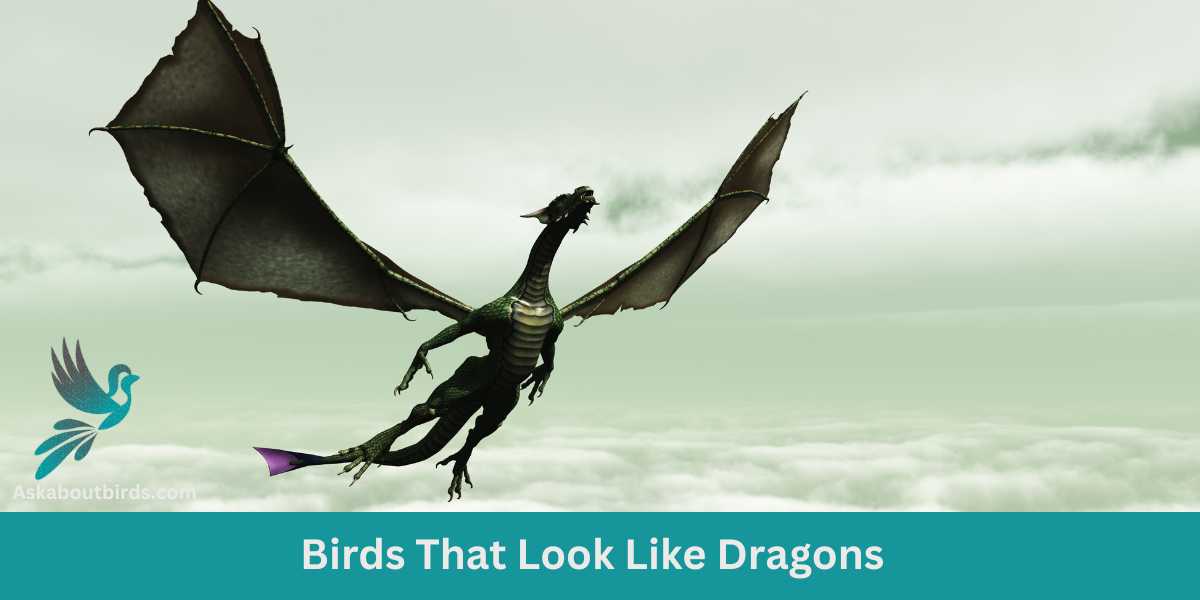There are some birds that look like they could be dragons straight out of your favorite fantasy worlds. With their striking scales and fierce features, they certainly make a statement. These birds have a certain otherworldly quality as if they belong in a mythical realm.
Whether they have a crest of horns or a sharp beak, they are sure to catch the eye of any observer. Their movements are graceful and fluid as if they are dancing on the wind. It’s no wonder that these birds have captured the imaginations of people for centuries.
Our Top 14 Dragon Bird Lookalikes:
Frigatebirds: Known for their impressive wingspan and the male’s red, inflated throat pouch, Frigatebirds can create a dragon-like silhouette in flight.
Secretary Birds: With long, crane-like legs, a sharp, hooked beak, and striking black crest feathers that can resemble the scales of a dragon, Secretary Birds are a great example.
Southern Cassowary: Considered one of the most dangerous birds in the world, the Southern Cassowary possesses a distinctive helmet-like casque on its head, and its large size and bold black plumage can evoke the image of a dragon.
Andean Condor: As one of the world’s largest flying birds, the Andean Condor, with its black plumage, white collar, and large wingspan, can appear very dragon-like, especially when soaring high in the sky.
Shoebill: With its large, shoe-like bill and intense gaze, the Shoebill stork can resemble a dragon, especially when it snaps its jaws shut like a steel trap.
Vulturine Guineafowl: The vibrant blue and striking patterns of the Vulturine Guineafowl, along with its helmet-like crown, could make it look like a fluffy little dragon.
Great Eared Nightjar: The prominent ‘ear’ tufts of the great eared nightjars can give it an almost dragon-like appearance, especially when its feathered wings are spread in flight.
Bearded Vulture: The Bearded Vulture, with its striking appearance, including red eyes, a hooked beak, and feathered legs, could very well resemble a dragon from fantasy stories.
Hoatzin: The spiky crest and bright blue facial skin of the Hoatzin, along with its unique wing claws in its juvenile stage, are quite reminiscent of dragons.
Great Blue Heron: The long neck, dagger-like bill, and broad wings of the Great Blue Heron can give it a dragon-like silhouette, especially in flight.
Sandhill Crane: Its long legs, slender neck, and pointed beak might remind some of dragons, particularly when seen in flight with its wide wingspan.
Cinereous Vulture: Also known as the black vulture, its dark color, bald head, and massive size can give this bird a dragon-like aura.
American White Pelican: With its large wingspan, long beak with a pouch, and high-soaring flight, the American White Pelican can create a dragon-like silhouette.
American Bald Eagle: Its sharp talons, hooked beak, and intense gaze give the American Bald Eagle a predatory, dragon-like appearance.
/Frigatebirds
Secretary Bird

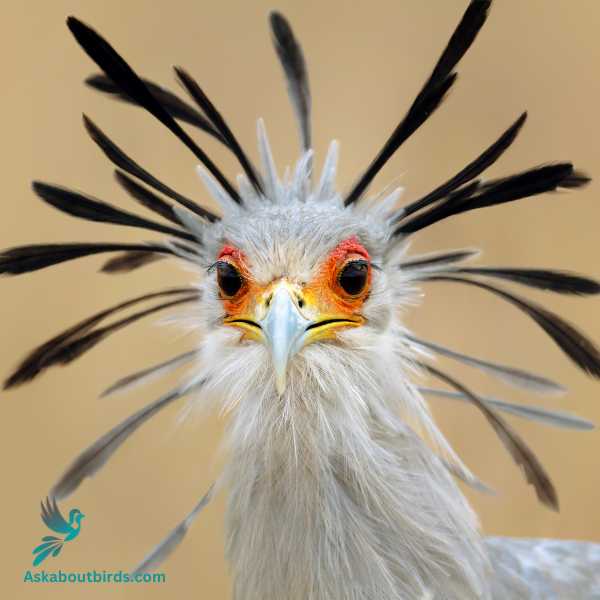
| Feature | Measurement |
|---|---|
| Scientific Name | Sagittarius serpentarius |
| Length | 4 to 4.5 feet |
| Wingspan | 6 to 7.5 feet |
| Weight | 8 to 10 llbs |
The Secretary Bird, is a unique bird of prey native to the open grasslands and savannas of sub-Saharan Africa. Unmistakable due to its long legs and eagle-like body, the Secretary Bird is unlike any other raptor.
It is well-known for its long, crane-like legs which it uses to hunt and deliver powerful kicks to its prey. The Secretary Bird has a short, hooked beak typical of birds of prey, and it possesses grey and black feathers with a distinctive black crest of long feathers at the back of its head.
Despite its ability to fly, the Secretary Bird spends most of its time on the ground, striding about the savanna in search of food. Its diet primarily consists of insects, rodents, lizards, snakes, and small birds. It is particularly famed for its skill in killing snakes, and it often uses its strong, agile legs to stamp on and stun its prey before delivering the fatal peck with its beak.
Cassowaries
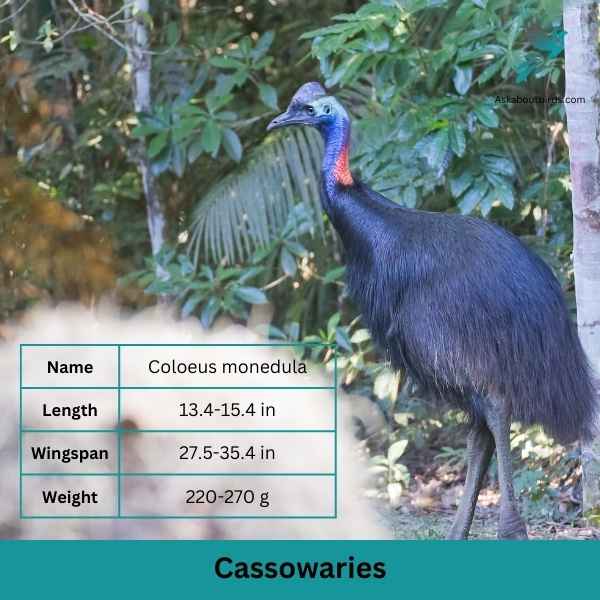

| Feature | Measurement |
|---|---|
| Scientific Name | Coloeus monedula |
| Length | 13.4-15.4 in |
| Wingspan | 27.5-35.4 in |
| Weight | 220-270 g |
Cassowaries are large, flightless birds native to the tropical forests of New Guinea, northeastern Australia, and the surrounding islands. They are one of the largest bird species in the world, standing up to 6 feet tall and weighing as much as 130 pounds. Cassowaries are instantly recognizable by their vibrant blue and red necks, sturdy black bodies, and a prominent casque, or helmet-like ridge, on top of their heads. This casque is thought to help in foraging by pushing aside foliage and in sound resonance.
In the wild, Cassowaries play a crucial role in the ecosystem, acting as efficient seed dispersers for numerous plants. They have a varied diet that includes fruit, fungi, insects, and small vertebrates. Despite their beauty, they are known to be potentially dangerous due to their powerful legs equipped with dagger-like claws.
Andean Condor
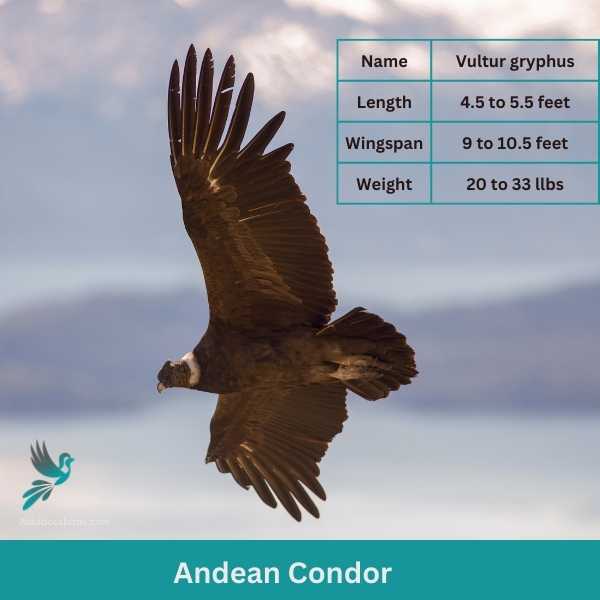

| Feature | Measurement |
|---|---|
| Scientific Name | Vultur gryphus |
| Length | 4.5 to 5.5 feet |
| Wingspan | 9 to 10.5 feet (2.7 to 3.2 meters) |
| Weight | 20 to 33 pounds (9 to 15 kilograms). |
The Andean Condor, one of the world’s largest flying birds, is a significant symbol in Andean cultures. Found in the mountain ranges of South America, this bird is easily recognized by its large size, black body, white collar of feathers around the neck, and large, bald head that can change color based on the bird’s emotional state. It is a scavenger by nature, feeding primarily on carrion, and is known to fly vast distances in search of food. The Andean Condor spends much of its time soaring on air currents high in the sky, using its massive wings, which provide the lift needed for it to stay aloft with minimal effort. They nest on inaccessible rock ledges up to 5,000 meters high. Given their long lifespan, which can be over 70 years in captivity, and their slow rate of reproduction, they are particularly susceptible to human impacts, making conservation efforts vital for this species.
Shoebills
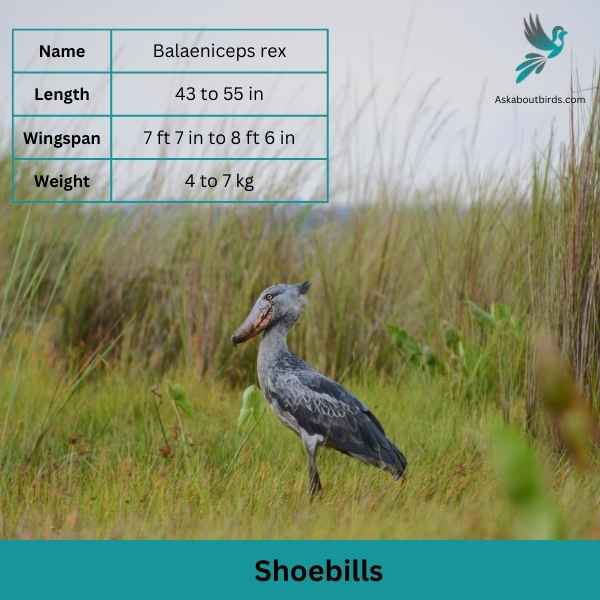

| Feature | Measurement |
|---|---|
| Scientific Name | Balaeniceps rex |
| Length | 43 to 55 in |
| Wingspan | 7 ft 7 in to 8 ft 6 in |
| Weight | 4 to 7 kg |
The Shoebill (Balaeniceps rex), also known as the Whalehead, is one of the most striking birds in the world due to its distinctive, large shoe-shaped bill. This enormous bill is well-adapted for catching and holding onto their preferred prey, which includes fish, amphibians, and small reptiles. The Shoebill stands tall, reaching heights of up to 5 feet, with an impressive wingspan that can extend over 8 feet. Its overall coloration is bluish-grey, and its broad wings and long legs further contribute to its imposing presence.
Native to East Africa, Shoebills primarily inhabit freshwater swamps and dense marshes. They are known for their statue-like stillness when hunting, where they can remain motionless for extended periods before striking with lightning speed to catch their prey. The Shoebill is considered a vulnerable species due to habitat loss, disturbance, and illegal wildlife trade.
Vulturine Guineafowl
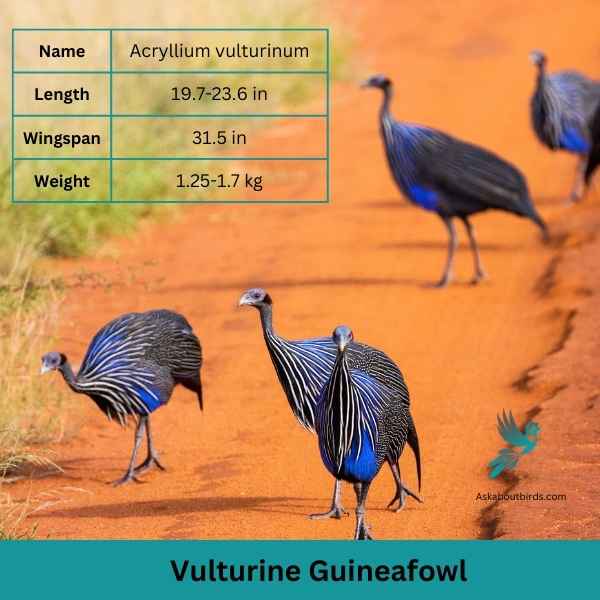

| Feature | Measurement |
|---|---|
| Scientific Name | Acryllium vulturinum |
| Length | 19.7-23.6 in |
| Wingspan | 31.5 in |
| Weight | 1.25-1.7 kg |
The Vulturine Guineafowl (Acryllium vulturinum) is a unique bird native to the arid regions of Northeast Africa. It is the largest and most visually striking of the guineafowl bird family. The species derives its name from its bald, vulture-like head and neck, which are adorned with blue and red hues, contrasted with its dark blue body feathers, which are finely striped with white. It also boasts a long, tassel-like structure hanging from its chest, and its back is covered in long, glossy, bluish-black wing and tail feathers.
Vulturine Guineafowl are terrestrial birds that prefer dry habitats like savannas and scrublands. These highly social creatures are usually found in large groups and feed primarily on seeds, fruits, and small invertebrates. They are unique among guineafowl for their relatively high degree of organization when moving as a group. While they have a wide range and large population, habitat loss and hunting can pose threats in certain areas, thus underlining the importance of management strategies to ensure their continued survival.
The Great Eared Nightjar

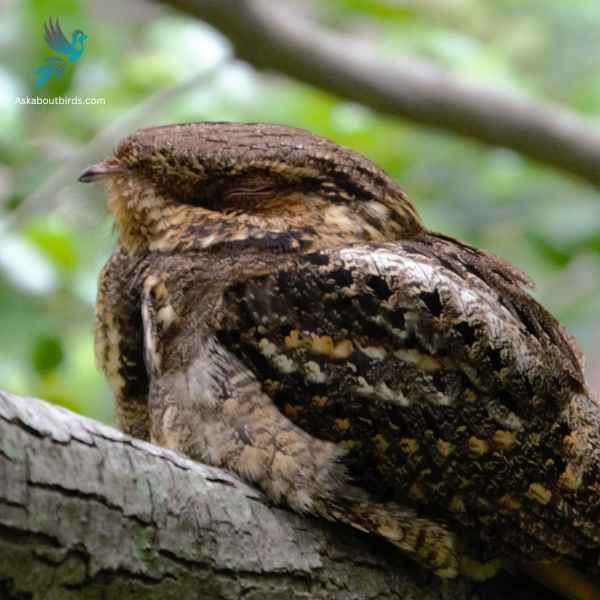
| Feature | Measurement |
|---|---|
| Scientific Name | Lyncornis macrotis |
| Length | 24–28 cm |
| Wingspan | 52–59 cm |
| Weight | 151 g |
The Great Eared Nightjar (Lyncornis macrotis) is a fascinating bird species known for its distinctive feather tufts or ‘ears’ that extend upwards from its head, giving it a cat-like appearance. The bird possesses a mix of brown, grey, and black hues across its body, allowing it to blend seamlessly with its environment. Their large, reflective eyes are adept at gathering light, equipping them for their nocturnal lifestyle.
Indigenous to the forested and scrub areas of Southeast Asia, the Great Eared Nightjar is a night hunter, active from dusk till dawn. Its diet primarily consists of insects such as beetles and moths, which it catches in flight using its large, gaping mouth. The bird’s cryptic coloring and daytime immobility make it hard to spot when roosting on the ground or perched on a branch. Despite its widespread distribution, the Great Eared Nightjar’s elusive nature means much of its behavior and life history remains a mystery, reinforcing the importance of continued field studies and conservation of its habitat.
Bearded Vulture
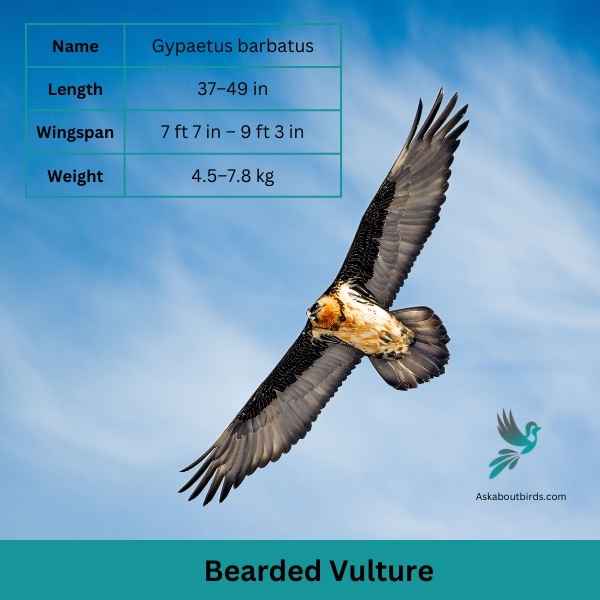

| Feature | Measurement |
|---|---|
| Scientific Name | Gypaetus barbatus |
| Length | 37–49 in |
| Wingspan | 7 ft 7 in – 9 ft 3 in |
| Weight | 4.5–7.8 kg |
The Bearded Vulture (Gypaetus barbatus), also known as the Lammergeier, is a distinct member of the vulture family, known for its unique feeding habits and striking physical appearance. Its large size, reaching lengths of up to 1.2 meters and a wingspan of over 2.5 meters, along with its reddish-brown body, pale head, and the dark feathers under the chin (resembling a beard), make it easily recognizable. This bird is also unique in its habit of applying soil to its feathers, which changes their color to a striking reddish-orange, believed to be a form of cosmetic enhancement.
The Bearded Vulture has an unusual diet for a bird of prey, mainly consuming the bone marrow of dead animals. It has a specialized technique for accessing the marrow, where it lifts bones high into the air and drops them onto rocks to shatter them. This remarkable bird is found in mountainous regions of Europe, Asia, and Africa, often nesting on cliff ledges. The species is currently considered near threatened, with population declines primarily driven by poisoning, disturbance, and collisions with power infrastructure, necessitating dedicated conservation measures.
Hoatzin
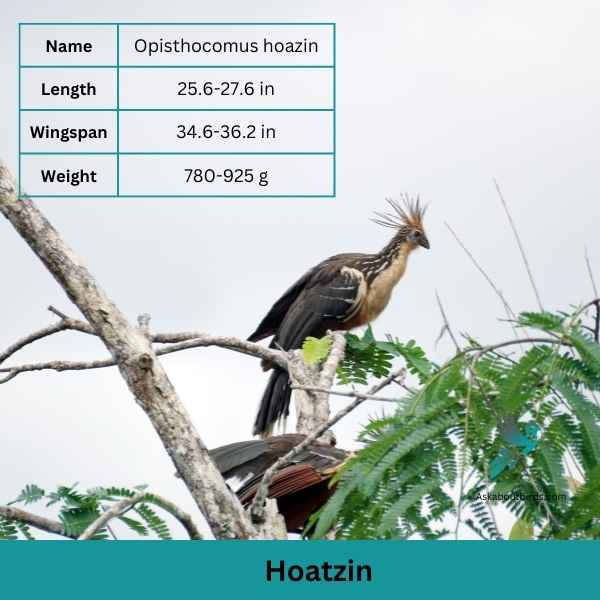
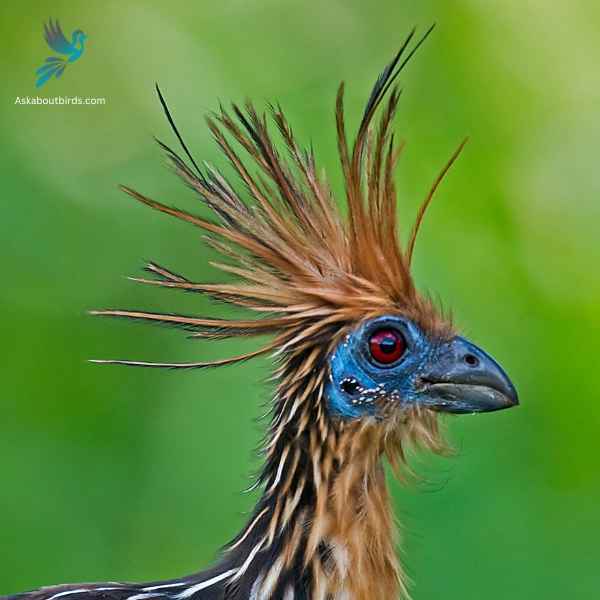
| Feature | Measurement |
|---|---|
| Scientific Name | Opisthocomus hoazin |
| Length | 25.6-27.6 in |
| Wingspan | 34.6-36.2 in |
| Weight | 780-925 g |
The Hoatzin (Opisthocomus hoazin) is a highly distinctive bird native to the swamps, mangroves, and riverine forests of the Amazon and the Orinoco delta in South America. Known for its peculiar appearance, it boasts a crest of long, spiky feathers on its head, a blue face with maroon eyes, and a body covered in chestnut, white, and black plumage. Its size is comparable to that of a pheasant, reaching a length of approximately 65 cm.
The Hoatzin is most famous for its unique digestive system. It’s one of the few bird species that is folivorous, meaning its diet consists primarily of leaves. To digest these, the Hoatzin uses a fermentation process similar to that in the stomach of a cow, which occurs in an unusually large crop. This diet and digestive method give the Hoatzin a strong, unpleasant smell, earning it the nickname of “stinkbird.” Another fascinating aspect of the Hoatzin is that the chicks are equipped with small claws on their wings, enabling them to climb trees until they are proficient fliers.
Great Blue Heron
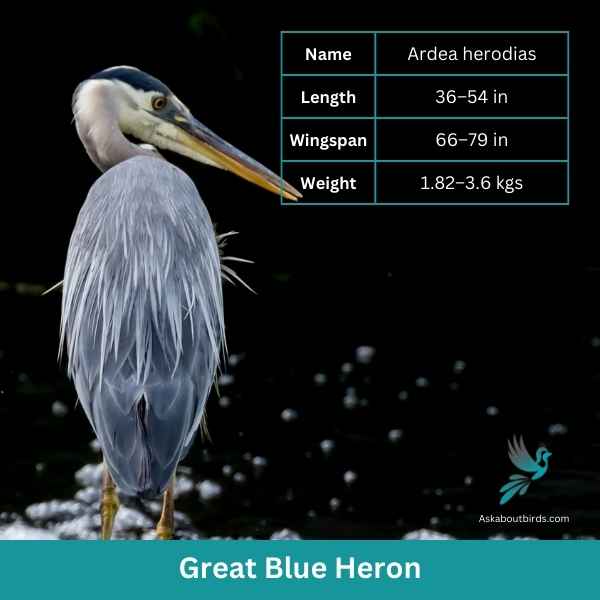
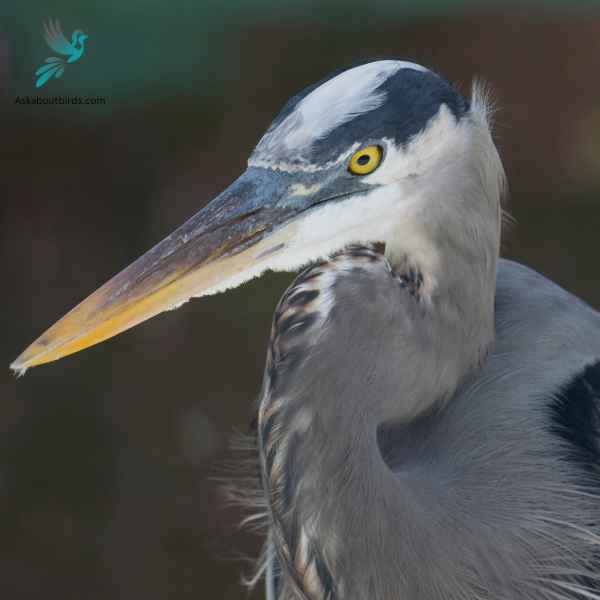
| Feature | Measurement |
|---|---|
| Scientific Name | Ardea herodias |
| Length | 36–54 in |
| Wingspan | 66–79 in |
| Weight | 1.82–3.6 kgs |
Great Blue Herons are the largest heron species in North America, is distinguished by its tall stature and unique blue-gray plumage.
Measuring up to 4.5 feet tall with a wingspan of approximately 6.5 feet, the bird features a long, pointed bill, a white head with a black eye stripe extending to slender black plumes, and robust, elongated legs. Its distinctive flight pattern, forming a tight “S” shape with its neck, sets it apart from similar large birds, like cranes.
Inhabiting various wetland habitats, including marshes, lakes, rivers, and coastal regions throughout much of North and Central America, the Great Blue Heron is a wading bird. Often seen poised statue-like at the water’s edge, these birds are expert hunters, spearing fish and capturing small animals with their sharp bills.
Sandhill Crane

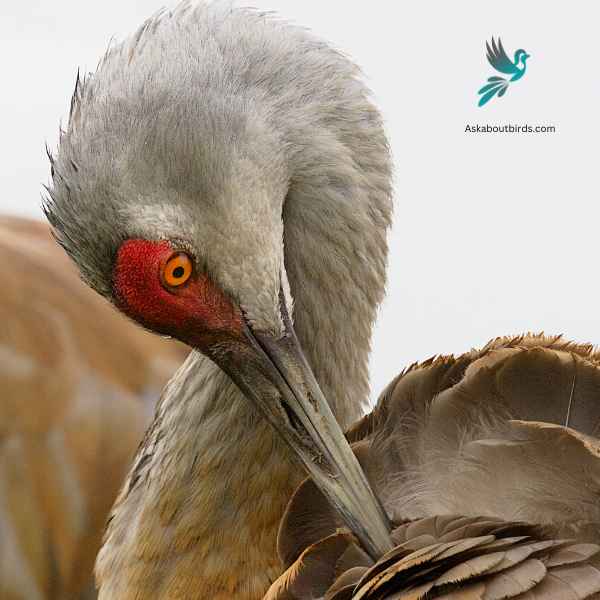
| Feature | Measurement |
|---|---|
| Scientific Name | Antigone canadensis |
| Length | 2 ft 7 in to 4 ft 6 in |
| Wingspan | 16.5–23.6 in |
| Weight | 4.02-4.57 kg |
The Sandhill Crane (Antigone canadensis) is a distinguished bird species found in the family Gruidae, renowned for its majestic presence and elaborate courtship dances.
These long-legged birds stand approximately 4 feet tall with a wingspan of up to 7 feet, marked by gray bodies, white cheeks, pointy dark bills, and an iconic red cap on their heads. Typically, they inhabit grasslands, marshes, and fields across North America, Siberia, and Cuba.
Being omnivorous, Sandhill Cranes thrive on a varied diet consisting of plant material, small mammals, amphibians, and insects. With a lifespan reaching up to 20 years in the wild, they remain one of the most widespread crane species globally.
Cinereous Vulture
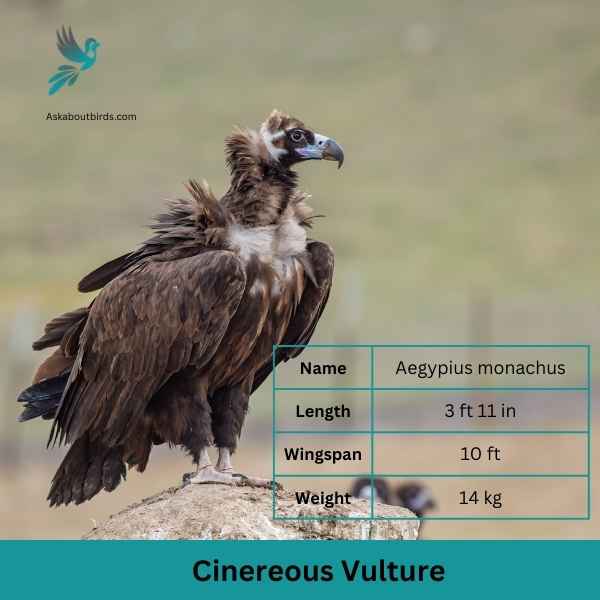

| Feature | Measurement |
|---|---|
| Scientific Name | Aegypius monachus |
| Length | 3 ft 11 in |
| Wingspan | 10 ft |
| Weight | 14 kg |
The Cinereous Vulture (Aegypius monachus), also known as the Eurasian Black Vulture, is one of the largest flying birds in the world and is considered the heaviest bird of prey. With a wingspan that can reach up to 3 meters and a body length of about 1 meter, this bird’s size is truly impressive. It is predominantly dark, with a bald, greyish head and neck, and deep brown eyes.
Native to parts of Europe and Asia, the Cinereous Vulture prefers to inhabit open, undisturbed areas such as high mountains, steppes, and semi-desert regions. It feeds primarily on carrion and can often be seen circling high above the ground in search of food, using its keen sight to spot carcasses from great distances. Although it has few natural predators due to its large size, the Cinereous Vulture is facing increasing pressure from human activities, such as poisoning, habitat loss, and disturbance, leading to a decline in its population in several areas. As a result, the species is currently listed as near threatened, highlighting the need for ongoing conservation efforts.
American White Pelican
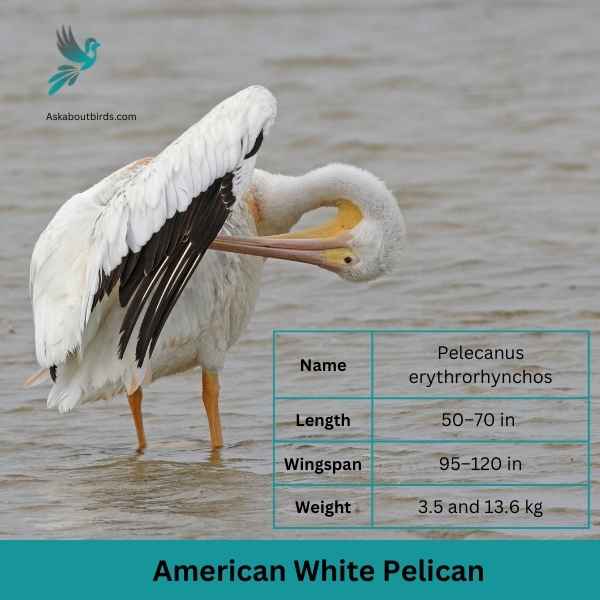

| Feature | Measurement |
|---|---|
| Scientific Name | Pelecanus erythrorhynchos |
| Length | 50–70 in |
| Wingspan | 95–120 in |
| Weight | 3.5 and 13.6 kg |
The American White Pelican (Pelecanus erythrorhynchos) is one of North America’s largest birds, distinguished by its brilliant white plumage, elongated orange bill, and massive wingspan, which can extend up to 3 meters. This bird has a unique appearance with its distinctive pouch used for feeding and a “horn” on the upper part of the bill during the breeding season. Though a large bird, it is very graceful in flight, often seen soaring in flocks in a V formation.
American White Pelicans inhabit lakes, marshes, and salt bays, and despite their size, they are excellent swimmers. They feed primarily on fish, using a cooperative hunting strategy where they encircle schools of fish in shallow water and then scoop them up in their bill pouches. Unlike their brown pelican relatives, they do not dive for their food. During the breeding season, these pelicans will nest in colonies on islands in freshwater lakes.
Bald Eagle


| Feature | Measurement |
|---|---|
| Scientific Name | Haliaeetus leucocephalus |
| Length | 70–102 cm (28–40 in) |
| Wingspan | 1.8 and 2.3 m (5 ft 11 in and 7 ft 7 in) |
| Weight | 3 and 6.3 kg (6.6 and 13.9 lb) |
The Bald Eagle is a bird of prey native to North America, most recognizable for its striking features: a white head and tail contrasted by a dark brown body. This raptor primarily feeds on fish, which it catches with its strong, sharp talons. Bald Eagles are renowned for their impressive flight skills and can reach high speeds in the air.
Their nests, or eyries, are some of the largest of any bird species, often built near bodies of water in tall trees or cliffs for an optimal view of their surroundings. Bald Eagles have a significant cultural status in the United States, serving as the national bird and a symbol of freedom.
Why do some birds resemble dragons?
Some bird species resemble dragons due to their unique physical traits and behaviors. Their striking appearances, often marked by bright colors, sharp beaks, and large wings, can remind us of fantastical animals from our favorite fantasy movies. For instance, the Secretary bird, with its long legs, hooked beak, and striking crest, seems like it could be straight out of Harry Potter movies.
Are there birds that have characteristics similar to dragons in real life?
Yes, several bird species possess characteristics that are reminiscent of dragons. Bearded Vultures, with their sharp beaks, red eyes, and feathered legs, have a striking appearance akin to a dragon. The Southern Cassowary, a Nocturnal bird. which roams the forest floor in Australia, has a helmet-like casque on its head, resembling the dragons we see in fantasy movies.
Are there any small bird species that resemble dragons?
Yes, there are even small bird species that can remind us of little dragons due to their bright colors and distinctive features. For example, the hummingbird can be likened to a “dragon fly” because of its hovering flight and iridescent feathers. These birds barely larger than insects have a magical appeal that fascinates many bird lovers.
How do birds protect themselves if they look like dangerous creatures?
Birds that resemble dangerous creatures, like dragons, often benefit from their looks. Predators may be hesitant to attack humans, other species, or even these birds themselves out of fear. This natural form of protection can help these birds thrive in their environments. For example, the well-camouflaged and fierce-looking Bearded Vulture is often left undisturbed due to its dragon-like appearance.
Is the resemblance of some birds to dragons purely coincidental?
While it’s tempting to think there’s a little magic involved, the resemblance of certain birds to Fluffy little dragons is coincidental and can be attributed to their evolution for survival in different environments. Like birds, dragons in lore often have features suited for survival, like fire-breathing for defense and wings for mobility, which is why there might be some parallels drawn between each creature.

